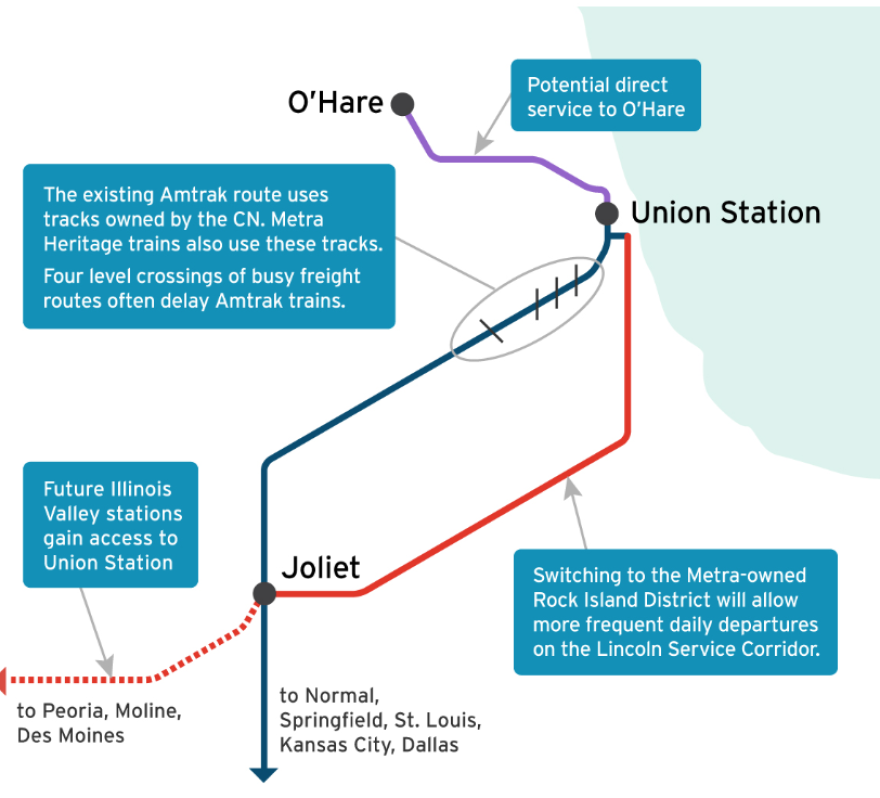Gov. JB Pritzker recently voiced support for the Chicago Hub Improvement Program [CHIP], a plan that also holds promise for Amtrak service through Bloomington-Normal. The investment in transportation infrastructure would fix several problems at Union Station and connect it to two potential passenger-focused main lines.
Pritzker’s statement foreshadows what rail advocates hope will be a robust discussion on the future of transit during the spring session of the Illinois General Assembly.
As proposed, CHIP would transfer state-supported Lincoln Service trains through Bloomington-Normal from the current Canadian National Lines to rail tracks owned by Metra in the Rock Island District. That would avoid frequent and frustrating traffic jams caused by freight trains between Joliet and Chicago.
The current route to Joliet has four delay points where trains can stall for significant periods of time.

The idea is not new. The Federal Railroad Administration [FRA] issued a "Record of Decision" in the Obama years that called for switching tracks. It was never funded, according to a spokesperson for Amtrak.
At the state level, it was tied to expanded state-supported daily trains on the Chicago-to-St. Louis corridor.
“It has been talked about for a long time. There was an environmental document put together about 10 years ago, for going from five daily round trips to 10. That suggested that was the proper way to go,” said Rick Harnish, executive director of the advocacy group, High Speed Rail Alliance. “Then-Gov. [Bruce] Rauner decided that we should stop doing the planning work. And so, it stalled. But Amtrak has really taken it up as an important issue.”
A spokesperson for the Illinois Department of Transportation [IDOT] said planning is in the early stages for the idea and declined an interview.
Amtrak has applied to the federal government for investment in CHIP that would expand and improve Chicago’s passenger rail capacity. Increasing frequency of trains on the Lincoln Service to take advantage of more timely and reliable service would require more state dollars.

Harnish said Amtrak has applied for federal funding for the Chicago Hub through the federal-state-partnership-for-intercity-passenger-rail program. The U.S. Secretary of Transportation is expected to announce awards in the next several weeks that will influence the scope of what state lawmakers talk about next spring.
The Rock Island District tracks have few freight movements, but adding Amtrak would probably require construction of a third line of track between Joliet and Chicago, said Harnish, adding capacity for a third line does not exist on the current Joliet route.
“The challenge on the existing corridor is that there are level crossings with four busy freight main lines that make it difficult to run trains through there reliably,” he said.
But there is room in existing right of way for that third line on the Metra-owned sections east of the present alignment.
“It's not complex. There are many highway projects that we're working on right now that are a lot more expensive and a lot more complex. It's just a matter of making a state commitment to make it easy to get from downstate Illinois to Chicago to O'Hare,” said Harnish.
Amtrak lumping the diversion to the Rock Island District tracks in with other large-scale improvements in CHIP may make it more politically achievable, Harnish agreed.
“I think so. And I think we need to convey to the governor and the legislature that Amtrak proposal is a good first step. But we need to be thinking much bigger with a lot more frequent service than what is currently being proposed,” he said.
Harnish said doubling the number of daily trains between Chicago and St. Louis would increase use even on the pre-existing trains because it would be more convenient and flexible for business use and the service would become more reliable overall.
“If you're in Normal and you want to go to Chicago, right now, there are a couple of trains in the morning. There's one in the middle of the day that may or may not be on time. And there's a couple of trains in the evening. But people travel throughout the day. There needs to be a train that gets to Chicago before the beginning of the business day. So, that puts it at about 8:30 or so midday train. So you can go to lunch, or if your afternoon meeting wraps up early and get back to Normal. And the ability to stay for a play or what-not and get back on,” said Harnish.
Use of the Rock Island tracks also would make aspirational passenger service more realistic, like that sought by Peoria advocates who want a route through Illinois River Valley communities to Chicago, he said. It makes use of Union Station possible instead of the Lasalle Street Station, which had previously been talked about for a Peoria service.
“It's really unfortunate that Peoria doesn't have trains," said Harnish. "They should have high frequency service throughout the day. And the best way to get there is following the river through Ottawa next to Starved Rock, Morris, and Joliet.”
He said an expansion of transit would make it easier for people to get around without a car and avoid the cost burden of a car, facilitating downstate living for people who do not want to drive into Chicago.
“There's going to be a very serious discussion, in the spring of this year, maybe lasting into the spring of 2025, about what we do statewide to improve our bus networks and our train networks, including the bus system for Bloomington- Normal. We believe that there needs to be a big expansion of transit throughout the state,” said Harnish.


